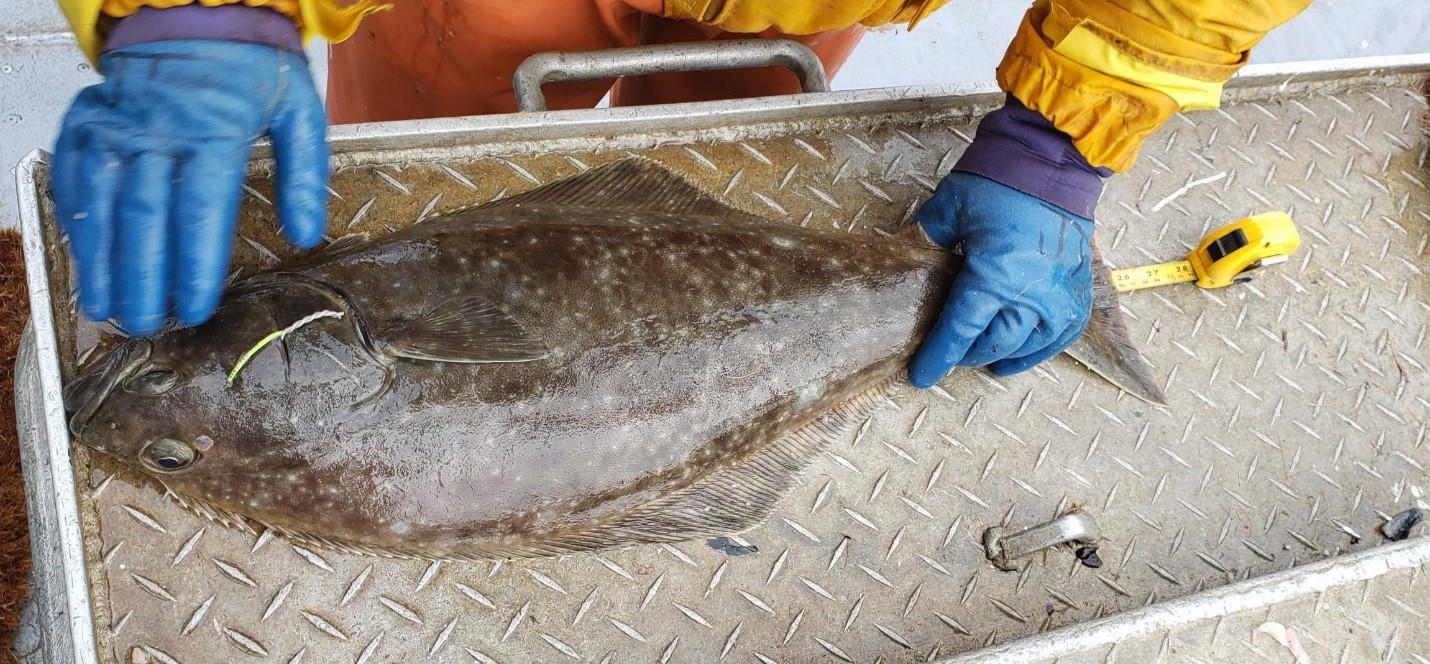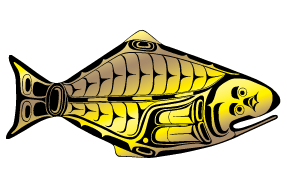A reward of a hat or $10 is offered for most recovered IPHC tags. Pacific halibut fishery regulations in Canada and the USA allow Pacific halibut of ANY size bearing an IPHC tag to be landed, whether or not the fisher holds Pacific halibut quota, and regardless of fishing gear or season.
You can contact IPHC (tag@iphc.int) to see if the port you are delivering to is staffed by an IPHC biologist who can assist in the data collection, or you can collect the data yourself. If it’s the latter case, there are a few things we’d like you to do:
A. Remove the tag from the fish

Wire tags and pop-up satellite transmitting (PAT) tags
Removal method depends on the type of tag.
- Traditional wire cheek tag can be removed by untwisting the wire and pulling it through the hole or cutting the cheek tissue.
- Pop-up archival transmitting (PAT) tags are attached to a black plastic leader which in turn is attached to a titanium-metal dart anchoring the tag assembly to the fish. Even after the tag body has released and popped up, the leader remains attached to the fish. The metal dart should be cut completely out of the fish and returned with the plastic leader.
- External electronic archival tags and external “dummy” archival tags are attached by plastic leader to a metal dart or by wires that run completely through the body of the fish through the dorsal musculature. The dart or wires should be cut out of the fish and collected along with the tag body and leader or cradle assembly.
- Internally-implanted electronic archival and “dummy” archival tags do not possess an attaching mechanism; the only thing to remove is the tag itself which will be inside the body cavity.
Don’t lose the tag–it’s the proof you’ll need to get your reward.
B. Measure the fork length of the fish
Measure the length of the fish (preferably in centimeters) from the tip of its mouth (chin) to the middle of the fork in its tail. The proper measurement is a flat, horizontal distance rather than a measurement which follows the contour of the fish. Please make certain the fish is on a flat surface and that the mouth is closed.

C. Cut out the otoliths
The otoliths, or earbones, are used to determine the age of the fish. There are 3 pairs of otoliths in each fish, although only 1 pair is easily visible.

- If the fish is round (gills and viscera intact) the first thing to do is to remove the gills. Make note of where the top part of the gills connects to the backbone: this is where you will find the otoliths.
- Lay the fish white side up and lift open the operculum, or gill cover. Run your finger along the backbone near where the gills used to be. You should feel a bulge. This is the otic capsule.
- Using a moderately sharp knife, make a shallow cut and take the top off the capsule. If done right, you should see a cavity with the otolith suspended within. Remove the otolith from the cavity.
- Turn the fish over and repeat procedure on the dark side.
- Place the otoliths in a protective container so that they are not crushed.
Link to Pacific halibut otolith removal video: https://youtu.be/2_ZT0eq3bjQ

D. Collect the data
In addition to the otoliths and fork length, we would like to collect the following information:
- Tag number: if the number is illegible, please do not discard the tag. We can often see the printing under magnification.
- Recovery date: when the fish was caught
- Recovery location: preferably latitude/longitude coordinates, though distance and bearing from a landmark would be acceptable (e.g. 3 miles SW of Cape Barto)
- Depth: the depth at which you were fishing, in fathoms (1 fathom = 6 ft)
- Sex: male or female, if known
- Gear type: e.g., longline, troll, trawl, pot, or sport
- Landing port: where the fish was brought in
- Vessel name and number: if commercially caught
- Name and complete mailing address
- Reward type: baseball cap or $10.
If more than one tagged fish is recovered, please keep the information from each fish separate.
Return this information to:
IPHC
2320 W. Commodore Way, Suite 300
Seattle WA 98199-1287 USA

